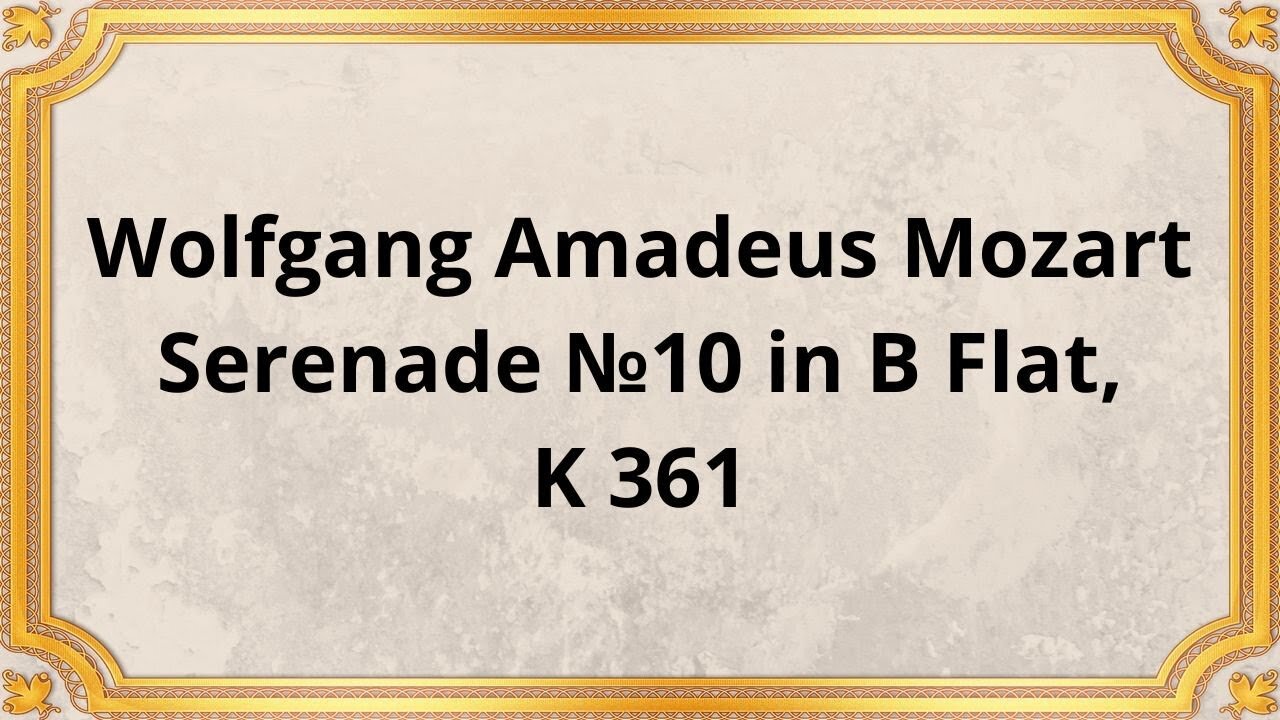Premium Only Content

Wolfgang Amadeus Mozart Serenade №10 in B Flat, K 361
#Mozart #SerenadeInBFlat #Music #Composition #Classical #18thCentury #Vienna #Musician #Composer #Orchestra #Woodwind #Brass #String #Ensemble #Melody #Harmony #Rhythm #Performance #Art #Genius #VienneseClassicalSchool #FamousComposer #MusicalGenius #HistoricalMusic #MusicHistory #MusicTheory #MusicalInfluence #Mozartian #MusicalProdigy
Edwin Fischer conducting His Chamber Orchestra
Publication date 1939
Wolfgang Amadeus Mozart, a musical genius of the Classical era, composed numerous masterpieces that continue to captivate audiences to this day. One such masterpiece is his Serenade No. 10 in B Flat, K 361.
Composed in 1781, Mozart's Serenade No. 10, also known as the "Gran Partita," was a work created during his time in Vienna. This period was marked by significant artistic and cultural development, with Mozart at the forefront, pushing boundaries and redefining classical music. The piece showcases Mozart's maturity as a composer, displaying his unparalleled ability to blend traditional forms with innovative musical techniques.
The Serenade No. 10 in B Flat, K 361 is a monumental work consisting of seven movements. Each movement showcases Mozart's exceptional craftsmanship, highlighting his command of diverse musical styles and emotions. The piece begins with a majestic and grandiose opening, followed by a series of contrasting movements, ranging from lively and playful to introspective and melancholic. The use of different instruments, including strings, woodwinds, and horns, adds depth and richness to the composition, creating a harmonious tapestry of sounds.
Noteworthy Movements:
1. Largo – Molto allegro: The first movement sets the tone for the entire serenade, with its bold and energetic melodies. Mozart expertly weaves together different musical themes, showcasing his mastery of counterpoint and orchestration.
2. Menuetto: This movement exudes elegance and grace, with its charming dance-like rhythm. The interplay between the various instruments creates a delightful musical conversation, demonstrating Mozart's ability to create nuanced and balanced compositions.
3. Adagio: The third movement slows the pace and takes the listener on a journey of introspection. It is characterized by its soul-stirring melodies and ethereal harmonies, reflecting Mozart's profound musical expression.
Mozart's Serenade No. 10 in B Flat, K 361 had a significant influence on the development of classical music. It showcased his ability to elevate the serenade genre to new heights, demonstrating the expressive potential of chamber music. The piece continues to be performed by orchestras worldwide, captivating audiences with its beauty and complexity.
Conclusion:
Wolfgang Amadeus Mozart's Serenade No. 10 in B Flat, K 361 stands as a testament to his exceptional talent and contribution to the world of classical music. With its intricate musical structure, emotional depth, and timeless appeal, this masterpiece continues to inspire and enchant audiences centuries later. As we immerse ourselves in the grandeur of this serenade, we are reminded of Mozart's genius and the enduring legacy he has left behind.
You have the opportunity to support the channel
https://www.donationalerts.com/r/radsiaral
-
 34:26
34:26
Classical music_Music Inspiration
1 month agoAram Khachaturian Concerto for Violin and Orchestra
802 -
 1:59:13
1:59:13
Adam Carolla
2 days agoBeing Republican & in Hollywood +Kelsey Grammer on Fatherhood + Peter Berg's Super Bowl Commercials
18.7K13 -
 18:29
18:29
DeVory Darkins
7 hours ago $12.06 earnedZelenskyy KICKED OUT of the White House after shouting match erupts
30.9K92 -
 2:23:02
2:23:02
Badlands Media
19 hours agoThe Liberty Den Ep. 133
59.8K31 -
 2:05:41
2:05:41
TimcastIRL
6 hours agoTrump SLAMS Ukraine President In TENSE WH Meeting, The War MAY END w/ Rob Smith | Timcast IRL
147K83 -
 10:31:05
10:31:05
Dr Disrespect
15 hours ago🔴LIVE - DR DISRESPECT - PGA TOUR 2K25 LAUNCH DAY
184K27 -
 2:30:04
2:30:04
Laura Loomer
6 hours agoEP105: MISSING: The Epstein Files
56.9K29 -
 1:46:14
1:46:14
Kim Iversen
7 hours agoTrump to Zelenskyy: 'You're Gambling with World War III'
67.8K108 -
 55:28
55:28
Glenn Greenwald
9 hours agoGlenn Reacts to Trump-Zelensky Exchange and Takes Q&A from our Members | SYSTEM UPDATE #415
111K197 -
 4:26:54
4:26:54
Nerdrotic
11 hours ago $36.13 earnedMarvel PANIC MODE! Kathleen Kennedy GONE?! Hollywood DEI Dead | Friday Night Tights 342 Nick Freitas
127K36